Natural Light Influence on Intellectual Performance. A Case Study on University Students
Abstract
1. Introduction
2. Materials and Methods
2.1. Population and Distribution
2.2. Environment
2.3. Course and Parameters Used in the Experiment
2.4. Process and Calculations
- The exam score of the whole population of the control group (windows) against the experiment group (basement).
- The attendance score in the same way as “1” above.
- Exam score of female vs. male population, H1 being female exam score will be higher.
- Attendance score of female vs. male population, H1 being female attendance will be better.
- Exam scores by year, with overlap of the number of students per class.
- Exam scores by year, separating male and female populations.
- Same as “2” above, but with the attendance scores.
3. Results and Discussion
3.1. Step 1. Comparison of the Whole “Windows”vs. “Basement” Populations Regarding Exam and Attendance Score
- Exam score “windows” vs. “basement”, p = 2.096 × 10−6, simplifying: p << 0.001, the alternative hypothesis is confirmed, the windows classroom exam scores will be better than those of the basement classroom, with a confidence level of 99.999%.
- Attendance score “windows” vs. “basement”, p = 0.143 the null hypothesis cannot be discarded, in other words, the “windows” classroom having better attendance scores than those of the “basement” classroom cannot be confirmed.
3.2. Step 2. Comparison of the the Full Male And Female Populations, Regarding Exam and Attendance Score
- Exam score female vs. male, p = 0.855, the alternative hypothesis cannot be confirmed, and therefore it is not possible to conclude that one group exam score will be better than the other.
- Attendance score female vs. male, p = 0.255 for the alternative hypothesis (female students having better attendance than male students), therefore it is not possible to conclude that one group attendance score will be better than the other.
3.3. Step 3. Checking the Possible Influence of Individual Circumstances of Each Year
3.4. Step 4. Further Testing by Individual Years, or by Year Groups
3.5. Summary
4. Conclusions
Supplementary Materials
Funding
Acknowledgments
Conflicts of Interest
References
- Robinson, W. The 1962 Sir Alfred Herbert paper: Lighting and the production engineer. Prod. Eng. 1963, 42, 123–139. [Google Scholar] [CrossRef]
- Boubekri, M. Daylighting Design: Planning Strategies and Best Practice Solutions; Birkhäuser: Basel, Switzerland, 2014. [Google Scholar]
- Webb, A.R. Considerations for lighting in the built environment: Non-visual effects of light. Energy Build. 2006, 38, 721–727. [Google Scholar] [CrossRef]
- Boyce, P.R. Review: The impact of light in buildings on human health. Indoor Built Environ. 2010, 19, 8–20. [Google Scholar] [CrossRef]
- USBGC. Daylight Credits in LEED v4.1. 2018. Available online: https://www.usgbc.org/credits/new-construction-schools-new-construction-retail-new-construction-data-centers-new-constru-4 (accessed on 20 April 2020).
- Hua, Y.; Oswald, A.; Yang, X. Effectiveness of daylighting design and occupant visual satisfaction in a leed gold laboratory building. Build. Environ. 2011, 46, 54–64. [Google Scholar] [CrossRef]
- Kralikova, R.; Piňosová, M.; Hricová, B. Lighting quality and its effects on productivity and human healts. Int. J. Interdiscip. Theory Pract. 2016, 10, 8–12. [Google Scholar]
- Altomonte, S. Ch2-lighting and physiology. Constr. Econ. Build. 2005, 5, 40–46. [Google Scholar] [CrossRef]
- Galasiu, A.D.; Veitch, J.A. Occupant preferences and satisfaction with the luminous environment and control systems in daylit offices: A literature review. Energy Build. 2006, 38, 728–742. [Google Scholar] [CrossRef]
- Gou, Z.; Lau, S.S.-Y.; Shen, J. Indoor environmental satisfaction in two leed offices and its implications in green interior design. Indoor Built Environ. 2012, 21, 503–514. [Google Scholar] [CrossRef]
- Buffoli, M.; Capolongo, S.; Cattaneo, M.; Signorelli, C. Project, natural lighting and comfort indoor. Ann. Ig. 2007, 19, 429–441. [Google Scholar] [PubMed]
- Kamali, N.J.; Abbas, M.Y. Healing environment: Enhancing nurses’ performance through proper lighting design. Procedia Soc. Behav. Sci. 2012, 35, 205–212. [Google Scholar] [CrossRef]
- Quartier, K.; Vanrie, J.; Van Cleempoel, K. As real as it gets: What role does lighting have on consumer’s perception of atmosphere, emotions and behaviour? J. Environ. Psychol. 2014, 39, 32–39. [Google Scholar] [CrossRef]
- Heshong Mahone Group. Skylighting and Retail Sales. An Investigation Into the Relationship between Daylighting and Human Performance; Pacific Gas and Electric Company: Fair Oaks, CA, USA, 1999. [Google Scholar]
- Larson, C.T. The Effect of Windowless Classrooms on Elementary School Children. 1965. Available online: https://eric.ed.gov/?id=ED014847 (accessed on 20 April 2020).
- Hathaway, W.E. A Study Into the Effects of Light on Children of Elementary School-Age--A Case of Daylight Robbery; Policy and Plaiming Branch, Planning and Information Services Division, Alberta Education: Alberta, AB, Canada, 1992.
- Nicklas, M.H.; Bailey, G.B. Analysis of the Performance of Students in Daylit Schools. Available online: https://eric.ed.gov/?id=ED458782 (accessed on 19 May 2020).
- McColl, S.L.; Veitch, J.A. Full-spectrum fluorescent lighting: A review of its effects on physiology and health. Psychol. Med. 2001, 31, 949–964. [Google Scholar] [CrossRef] [PubMed]
- Pulay, A.; Williamson, A. A case study comparing the influence of led and fluorescent lighting on early childhood student engagement in a classroom setting. Learn. Environ. Res. 2019, 22, 13–24. [Google Scholar] [CrossRef]
- Heshong Mahone Group. Daylighting in Schools an Investigation Into the Relationship between Daylighting and Human Performance; Pacific Gas and Electric Company, California Board for Energy Efficiency: Fair Oaks, CA, USA, 1999. [Google Scholar]
- Korea University. Homepage of the Department of Architecture. Available online: https://doa.korea.edu (accessed on 17 May 2020).
- Korea University. Bachelor of Architecture Curriculum. Available online: https://doa.korea.edu/archi_en/matriculate/curriculum.do (accessed on 17 May 2020).
- PHILLIPS. Simply Energy Saving, Master TL-d Eco. 2020. Available online: https://www.assets.signify.com/is/content/PhilipsLighting/comf2538-pss-global (accessed on 17 May 2020).
- Forbes, C.; Evans, M.; Hastings, N.; Peacock, B. Statistical Distributions; John Wiley & Sons: Hoboken, NJ, USA, 2011. [Google Scholar]
- Hastie, T.; Tibshirani, R.; Friedman, J. The Elements of Statistical Learning: Data Mining, Inference, and Prediction; Springer Science & Business Media: Berlin, Germany, 2009. [Google Scholar]
- Mann, H.B.; Whitney, D.R. On a test of whether one of two random variables is stochastically larger than the other. Ann. Math. Stat. 1947, 18, 50–60. [Google Scholar] [CrossRef]
- Tukey, J.W. Box-and-Whisker Plots. In Exploratory Data Analysis; Pearson: London, UK, 1977; pp. 39–43. ISBN 978-0201076165. [Google Scholar]
- Python Software Foundation, Python Programming Language. Available online: https://www.python.org/ (accessed on 19 April 2020).
- Scipy-Developers. Scipy Library. Available online: https://www.scipy.org/scipylib/index.Html (accessed on 19 April 2020).
- The Pandas Development Team, Pandas. Available online: https://pandas.pydata.org/ (accessed on 19 April 2020).
- Waskom, M. Seaborn: Statistical Data Visualization. Available online: https://seaborn.pydata.org/index.Html (accessed on 19 April 2020).



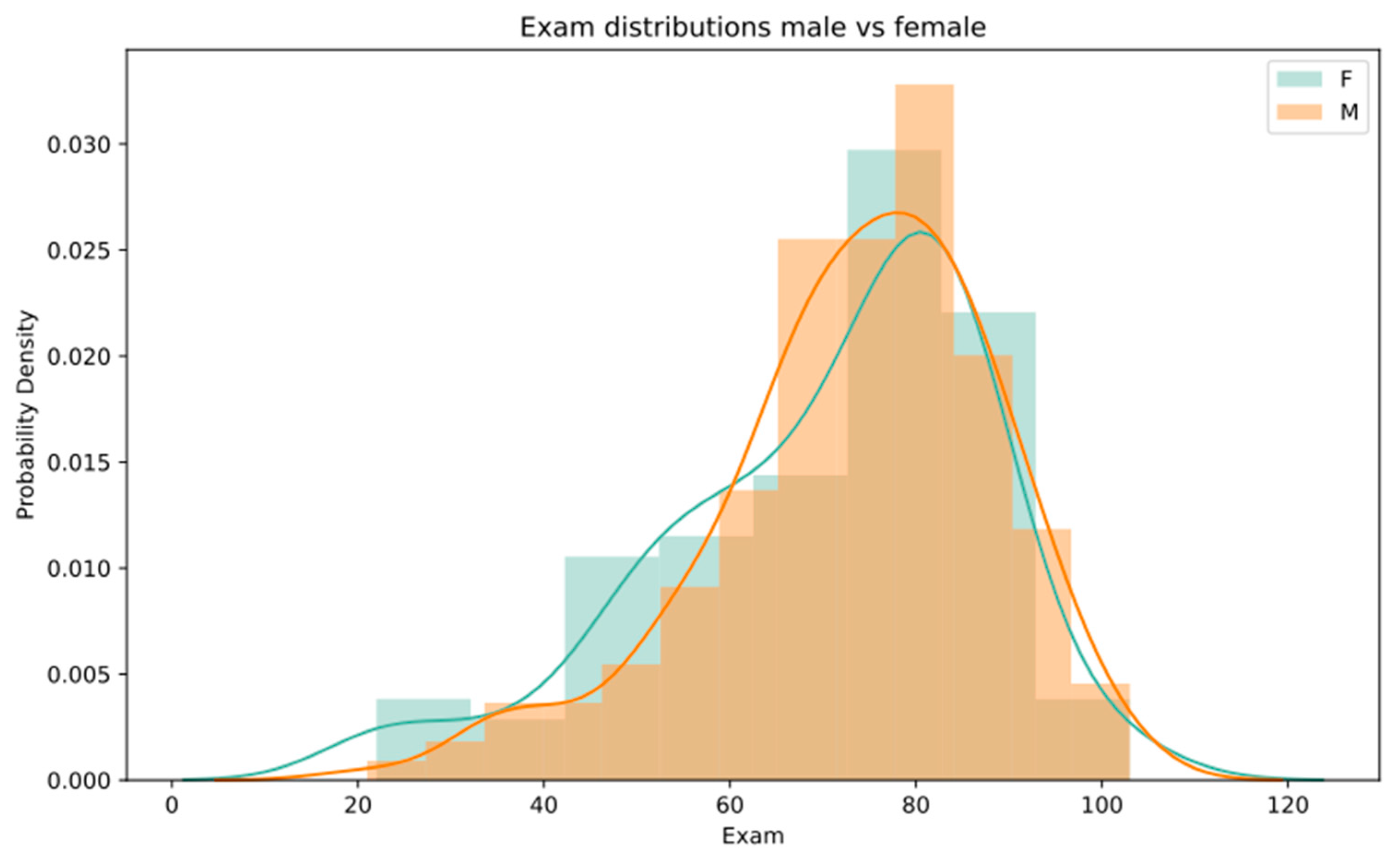
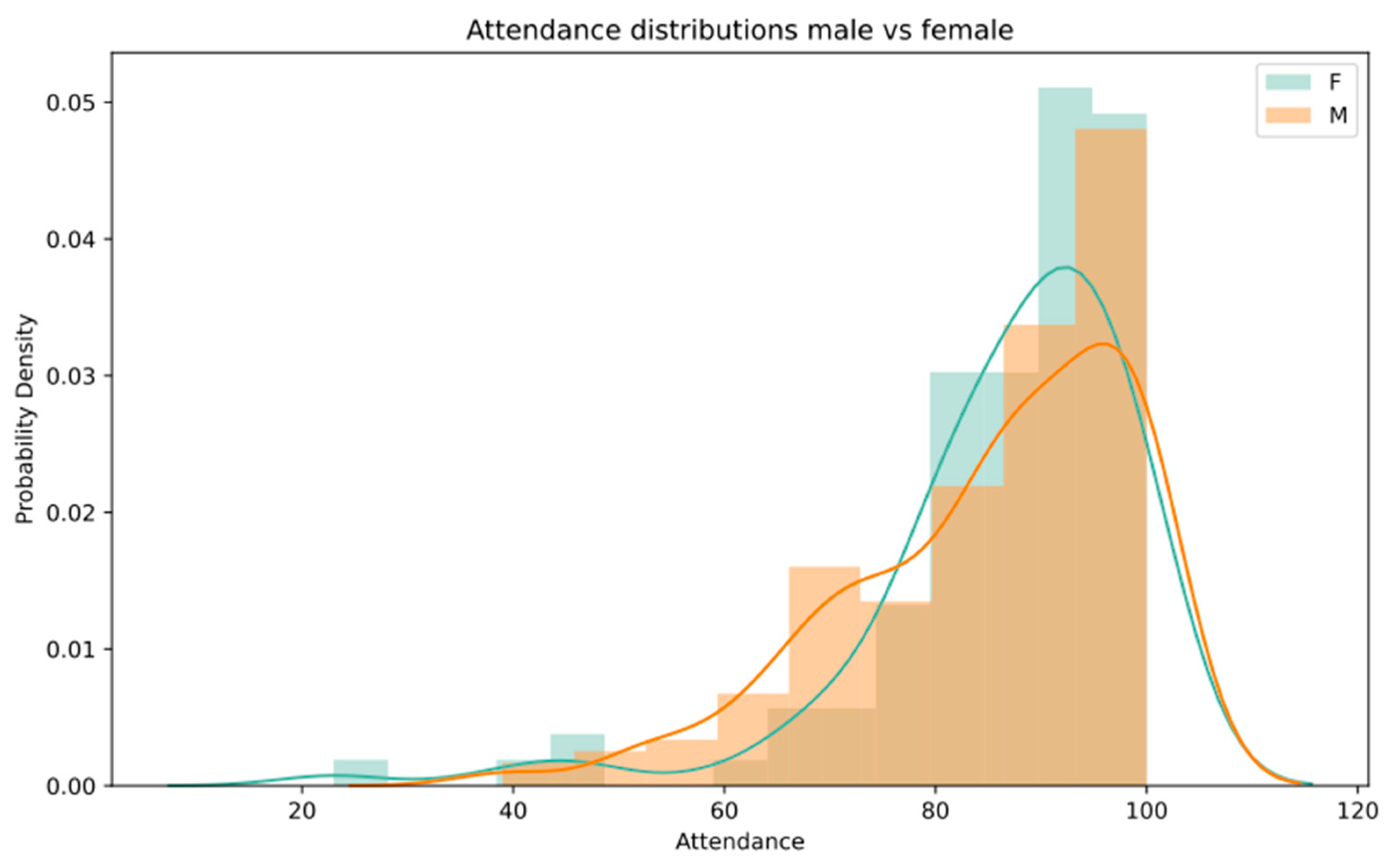

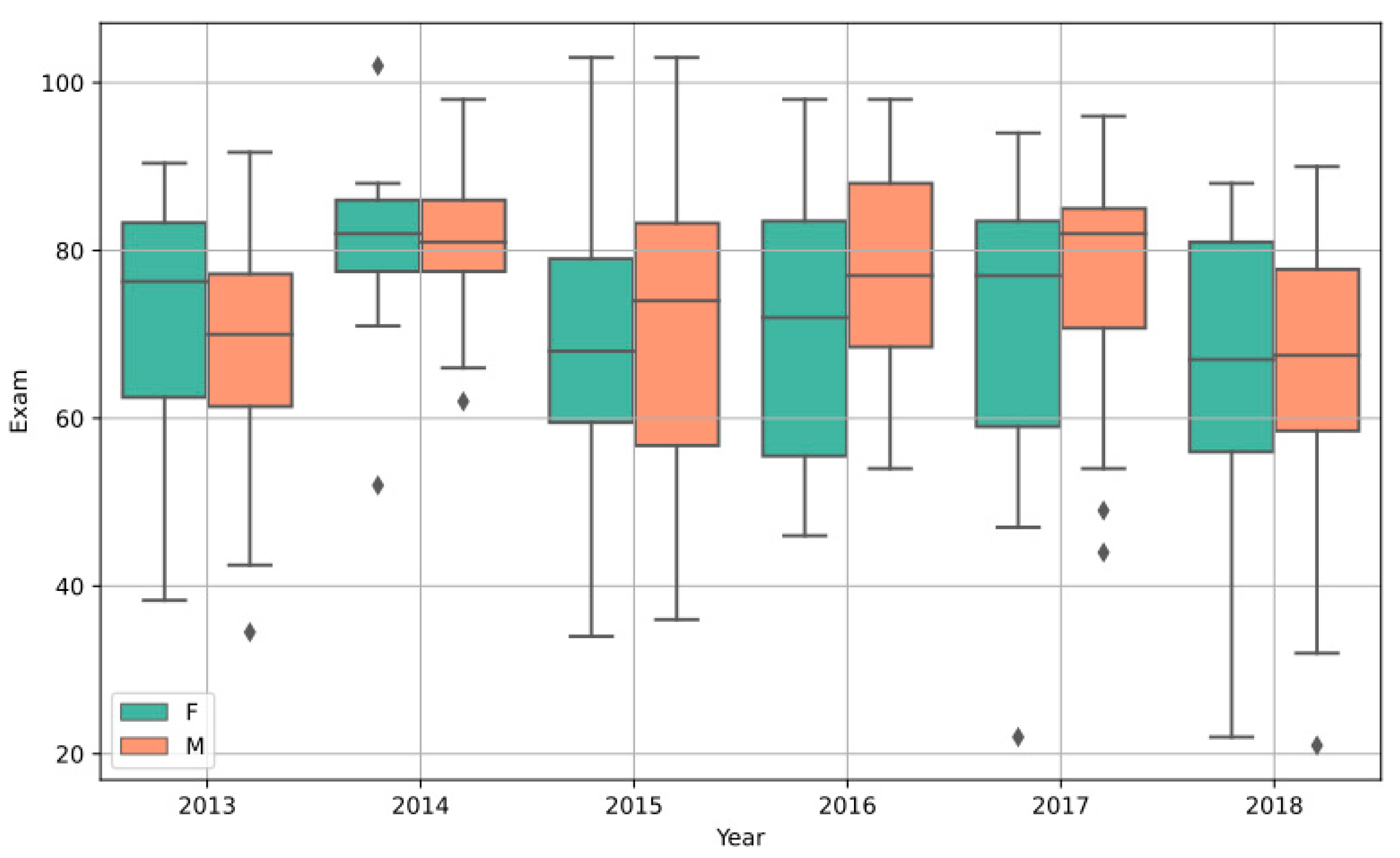

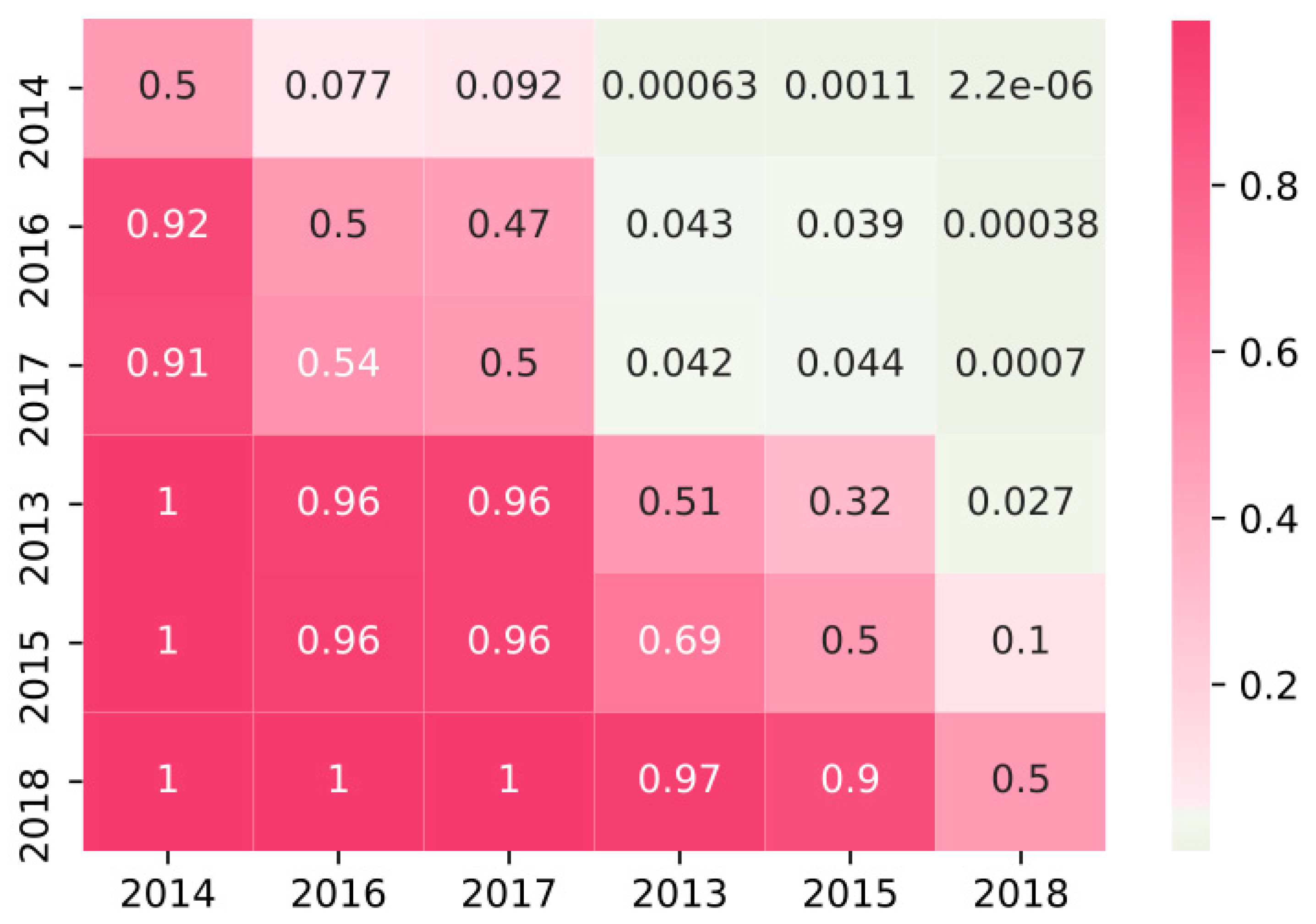
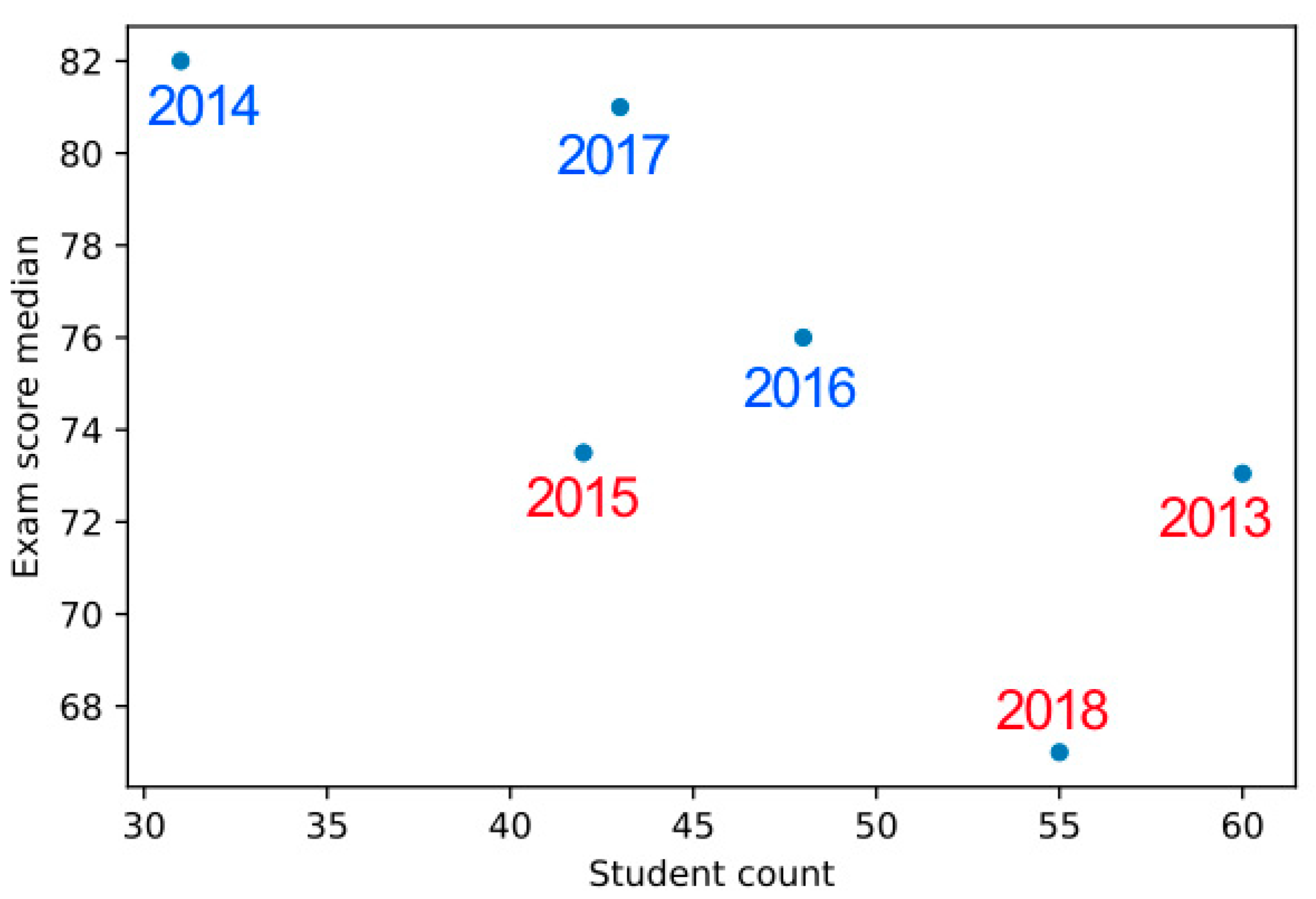
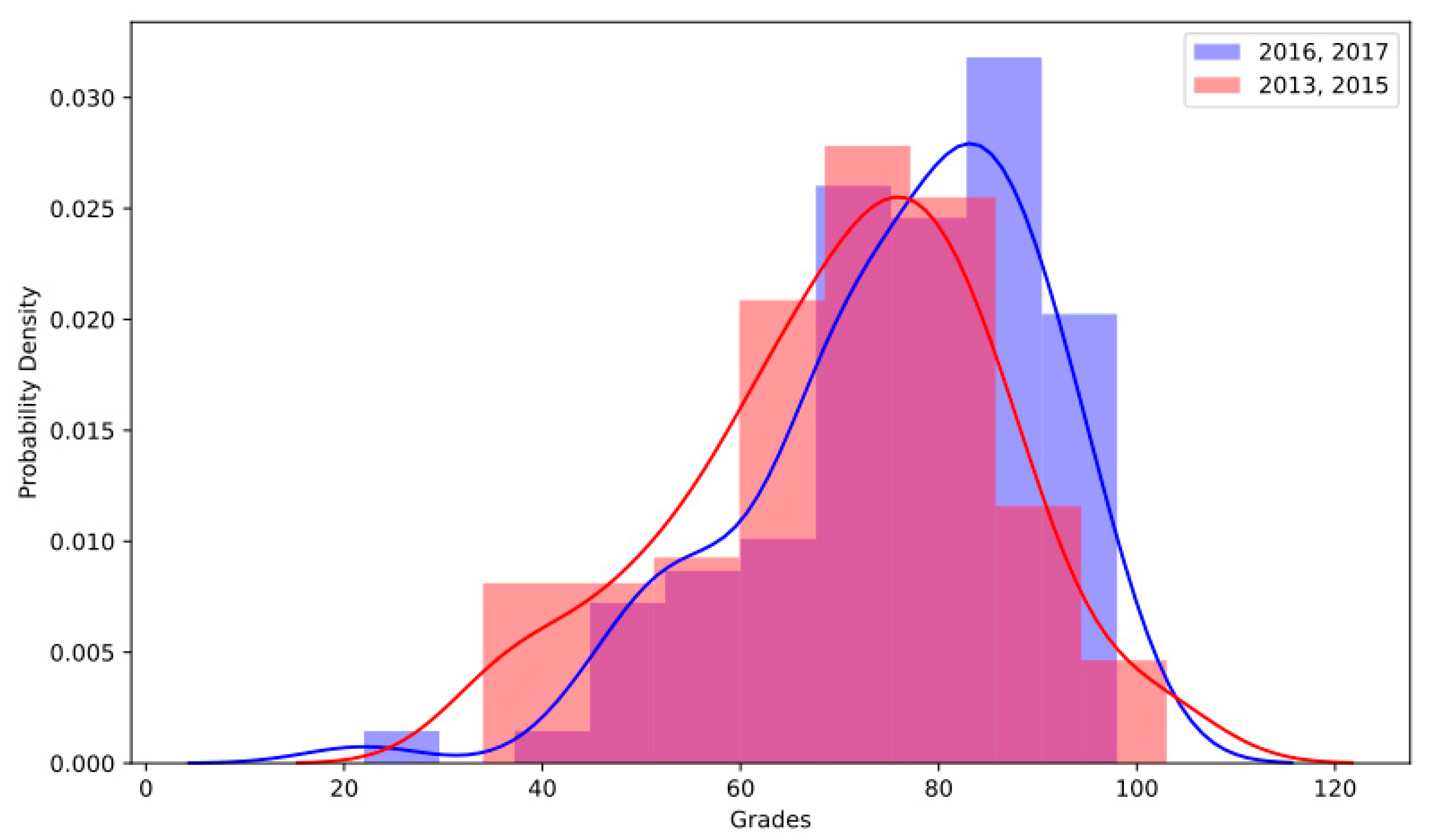
| Year | Classroom | Female (F) | Male (M) | F Ratio | M Ratio | Total |
|---|---|---|---|---|---|---|
| 2013 | Basement | 25 | 34 | 0.43 | 0.57 | 59 |
| 2015 | Basement | 20 | 22 | 0.39 | 0.61 | 42 |
| 2018 | Basement | 21 | 34 | 0.48 | 0.52 | 55 |
| Tot. Basement | 66 | 90 | 0.42 | 0.58 | 156 | |
| 2014 | Windows | 12 | 19 | 0.21 | 0.79 | 31 |
| 2016 | Windows | 10 | 38 | 0.35 | 0.65 | 48 |
| 2017 | Windows 1 | 15 | 28 | 0.38 | 0.62 | 43 |
| Tot. Windows | 37 | 85 | 0.30 | 0.70 | 122 | |
| Total Students | 103 | 175 | 0.37 | 0.63 | 278 |
| Parameters | Exam Windows | Exam Basement | Att. Windows | Att. Basement |
|---|---|---|---|---|
| Count | 122 | 156 | 122 | 156 |
| Mean | 77.19 | 68.21 | 86.93 | 84.85 |
| Std | 13.71 | 16.90 | 12.50 | 14.08 |
| Minimum | 22.00 | 21.00 | 39.00 | 23.00 |
| 25% | 70.00 | 59.25 | 80.50 | 77.90 |
| 50% | 80.00 | 70.00 | 90.00 | 87.00 |
| 75% | 86.00 | 80.00 | 97.00 | 96.7 |
| Maximum | 102.00 | 103.00 | 100.00 | 100.00 |
| Parameters | Exam Female | Exam Male | Att. Female | Att. Male |
|---|---|---|---|---|
| Count | 103 | 175 | 103 | 175 |
| Mean | 70.23 | 73.31 | 86.58 | 85.29 |
| Std | 17.54 | 15.25 | 13.21 | 13.56 |
| Minimum | 22.00 | 21.00 | 23.00 | 39.00 |
| 25% | 59.15 | 66.00 | 81.65 | 77.00 |
| 50% | 75.00 | 75.90 | 90.00 | 88.00 |
| 75% | 83.00 | 84.00 | 94.15 | 97.25 |
| Maximum | 103.00 | 103.00 | 100.00 | 100.00 |
| Parameters | Exam Windows | Exam Basement |
|---|---|---|
| Count | 91 | 100 |
| Mean | 75.81 | 70.37 |
| Std | 14.56 | 15.74 |
| Minimum | 22.00 | 34.00 |
| 25% | 68.00 | 61.03 |
| 50% | 78.00 | 73.40 |
| 75% | 86.00 | 81.18 |
| Maximum | 98.00 | 103.00 |
| Populations Tested | H1 | Mean Values | p-Value | Result |
|---|---|---|---|---|
| All W vs. B | Exam W > B | 77.19(W); 68.21(B) | p << 0.001 | true |
| All W vs. B | Att W > B | 86.93(W); 84.85(B) | p = 0.143 | false |
| All F vs. M | Exam F > M | 70.23(F); 73.31(M) | p = 0.855 | false |
| All F vs. M | Att F > M | 86.58(F); 85.29(M) | p = 0.255 | false |
| Every Y vs. every other Y | Exam WY > BY | -- | p = 0.044 to p << 0.001 | true |
| W vs. B except extreme Y | Exam W > B | 75.81(W); 70.37(B) | p = 0.007 | true |
© 2020 by the author. Licensee MDPI, Basel, Switzerland. This article is an open access article distributed under the terms and conditions of the Creative Commons Attribution (CC BY) license (http://creativecommons.org/licenses/by/4.0/).
Share and Cite
Porras Álvarez, S. Natural Light Influence on Intellectual Performance. A Case Study on University Students. Sustainability 2020, 12, 4167. https://doi.org/10.3390/su12104167
Porras Álvarez S. Natural Light Influence on Intellectual Performance. A Case Study on University Students. Sustainability. 2020; 12(10):4167. https://doi.org/10.3390/su12104167
Chicago/Turabian StylePorras Álvarez, Santiago. 2020. "Natural Light Influence on Intellectual Performance. A Case Study on University Students" Sustainability 12, no. 10: 4167. https://doi.org/10.3390/su12104167
APA StylePorras Álvarez, S. (2020). Natural Light Influence on Intellectual Performance. A Case Study on University Students. Sustainability, 12(10), 4167. https://doi.org/10.3390/su12104167





